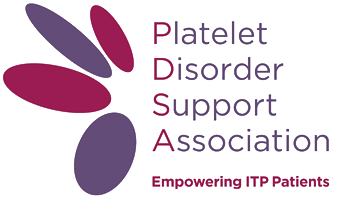There are many treatments for ITP. All treatment options have different risks and benefits, and some can be toxic causing serious side effects. It is important to understand both the success rate and potential side effects before beginning a treatment.
The general types of conventional treatments include:
Antibiotics
An ITP diagnosis and the low platelet count it causes are sometimes associated with a bacterial infection—and antibiotics used to fight the infection have been shown to raise platelet counts. There has been considerable research on the success of antibiotics used to treat the H. pylori (helicobacter pylori) bacteria infection in those diagnosed with ITP. The treatment and eradication of other infections can also help raise the platelet count.
Anti-Rho(D)
Anti-RhoD (WinRho®) is an intravenous (IV) drug infusion used to elevate platelet counts temporarily, and can be repeated over a period of time for extended relief. Often used as a “first line” therapy, the shorter infusion time and often lower cost of Anti-RhoD can offer an advantage over intravenous immunoglobulin (IVIG) for some patients.
Select a treatment table to view or download below.
Anti-Rho(D) Treatment Tables
B-Cell Depletion Therapy
B-cell depletion by a monoclonal antibody (anti-CD20, rituximab [Rituxan®]) is a widely used treatment choice, but has not been approved by the Food and Drug Administration (FDA) to treat ITP. B-cell depletion works by disabling and changing B-cells, a type of white blood cell.
Select a treatment table to view or download below.
Rituximab Treatment Tables
Chemotherapy
Various chemotherapy drugs, including vincristine (Oncovin®) and cyclophosphamide (Cytoxan®) have been used as a second or third-line treatment choice for chronic ITP patients. Each has a slightly different side effect profile. While they have been effective in a small percentage of cases, chemotherapy drugs can be quite toxic and have not been approved by the FDA to treat ITP.
Select a treatment table to view or download below.
Cyclophosphamide Treatment Tables
Vincristine Treatment Tables
Corticosteroids
Many doctors consider corticosteroids (steroids) for their initial approach for newly diagnosed patients. While corticosteroids (prednisone or dexamethasone) are a commonly used “front line” therapy and have been shown to increase the platelet count while being taken, the FDA has not approved them for the treatment of ITP. The type, dose and duration depend on the patient's particular condition and tolerance.
Select a treatment table to view or download below.
Prednisone Treatment Tables
Dexamethasone Treatment Tables
Immunosuppressants
Immunosuppressants, including azathioprine (Imuran®), cyclosporine (Sandimmune®), diphenylsulfone (Dapsone®), Sirolimus (Rapamycin®), and mycophenolate mofetil (Cellcept®), are considered a second or third-line treatment for ITP. This class of drugs is used to treat other autoimmune diseases, including multiple sclerosis (MS) and lupus, but none have gained FDA approval to treat ITP.
Select a treatment table to view or download below.
Cyclosporine Treatment Tables
Imuran Treatment Tables
Mycophenolate Mofetil Treatment Tables
Dapsone Treatment Tables
Sirolimus Treatment Tables
Intravenous Immunoglobulin (IVIG)
Intravenous immunoglobulin (IVIG) is a type of antibody treatment used as a “front line” therapy to temporarily elevate platelet counts. Although IVIG is not expected to result in a sustained, elevated platelet count, in rare cases this does occur and the drug can be repeated for longer lasting results. IVIG is manufactured by several companies, some of which have received FDA approval for its use in the treatment of ITP.
Select a treatment table to view or download below.
IVIG Treatment Tables
Modified Testosterone
The synthetic androgen (male sex hormone) danazol (Danocrine®) is sometimes used to treat ITP when other treatments have failed. Danazol is considered a second-line treatment, used after other treatments are considered or fail.
Select a treatment table to view or download below.
Danazol Treatment Tables
Platelet Destruction Inhibition
A new approach to treating ITP is the use of a spleen tyrosine kinase (SYK) inhibitor. The agent fostamatinib disodium hexahydrate (TAVALISSE™) may slow the destruction of antibody-coated platelets in people with chronic ITP by specifically targeting SYK. Spleen tyrosine kinase (SYK) is part of a network of proteins (found in certain cells of the immune system) that triggers platelet destruction.
Platelet Growth Factors
Second-line ITP treatment approach using platelet growth factors or thrombopoietin (TPO) receptor agonists. These agents, avatrombopag (Doptelet®), eltrombopag (Promacta®/Revolade®), and romiplostim (Nplate®), stimulate the bone marrow to produce more platelets. Once thought to be only a disease of platelet destruction, research advances have shown that many people with ITP also have a platelet production problem which is believed to be caused by the same antibodies and cells that attack the platelets.
Select a treatment table to view or download below.
Avatrombopag
Treatment Tables
Eltrombopag (Promacta/Revolade)
Treatment Tables
Romipostim (NPlate)
Treatment Tables
Splenectomy
This is a surgical procedure to remove the spleen. The spleen is a large blood filter, which for many people removes antibody-coated platelets. Theoretically, if the spleen is removed, the platelets will remain in circulation. However, there are other ways the body removes platelets, so this treatment sometimes fails to have a lasting effect.
Select a treatment table to view or download below.
Splenectomy Treatment Tables
Watchful Waiting
More of a strategy than a treatment, ‘Watchful Waiting’ means choosing to live with you or your child's current platelet counts while carefully monitoring the disease and treatment options.
Select a treatment table to view or download below.
Watchful Waiting Treatment Tables
Treatment information does not represent an endorsement by PDSA or its medical advisors. For advice on your unique medical condition, please consult your healthcare provider.

